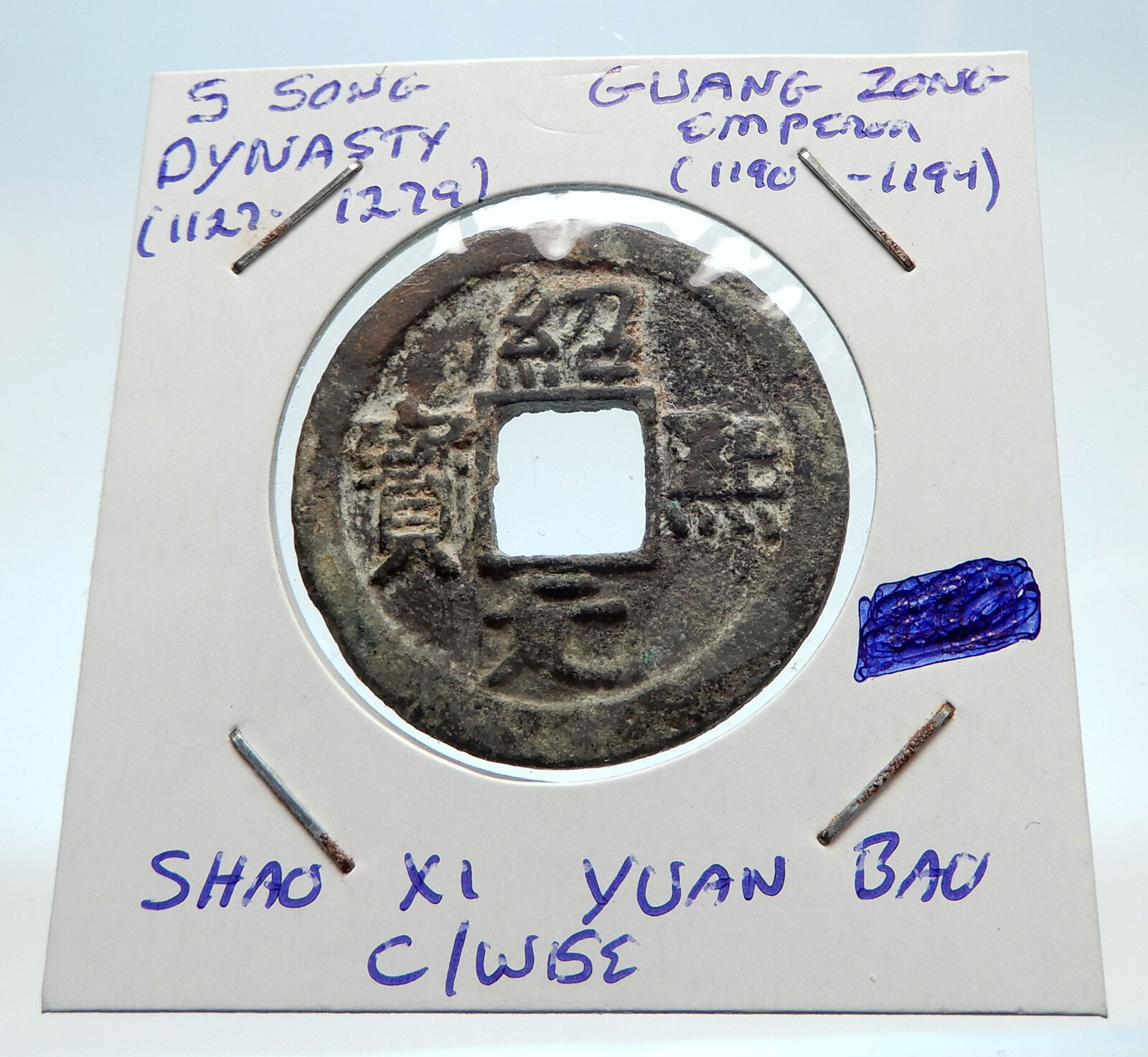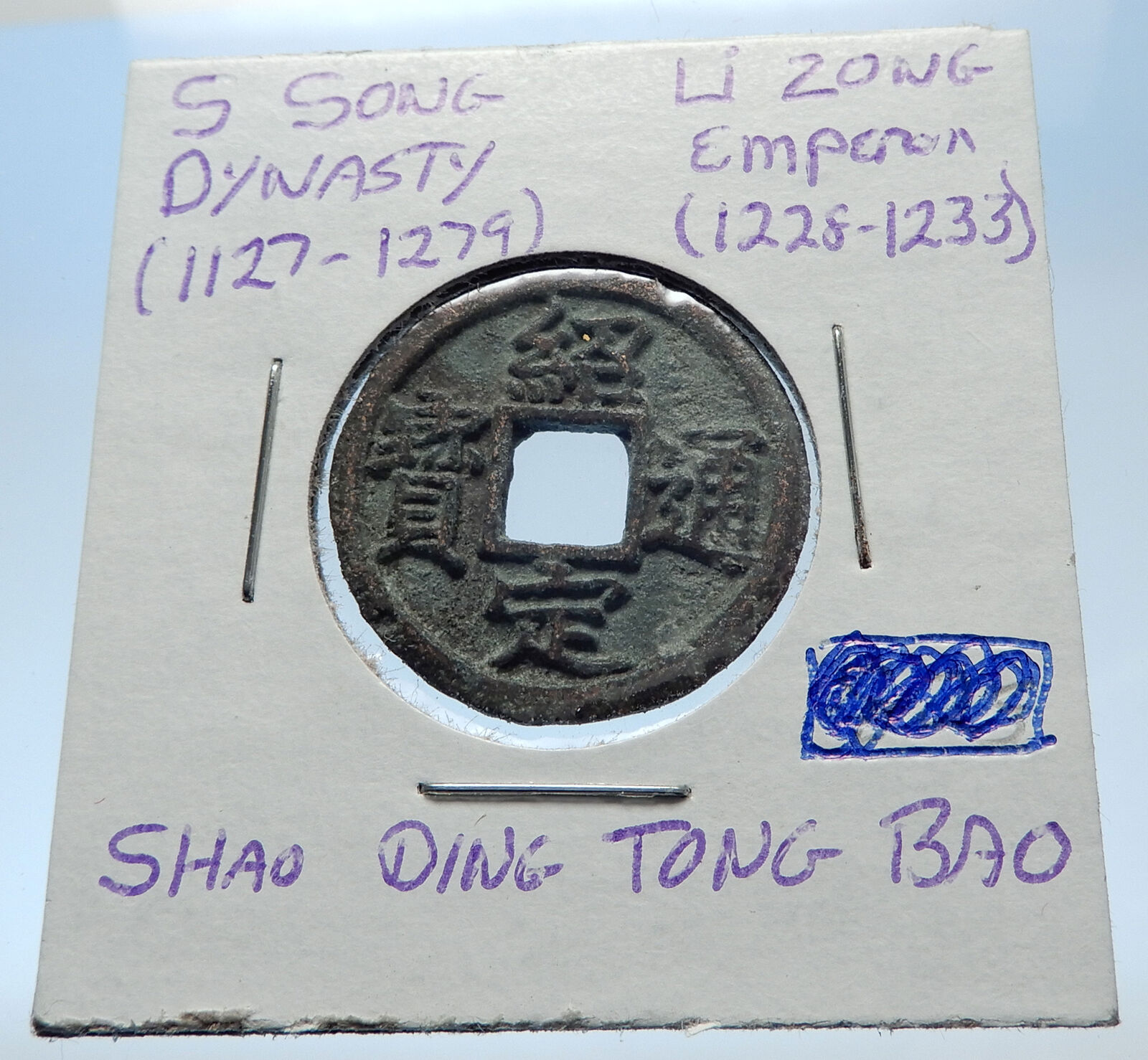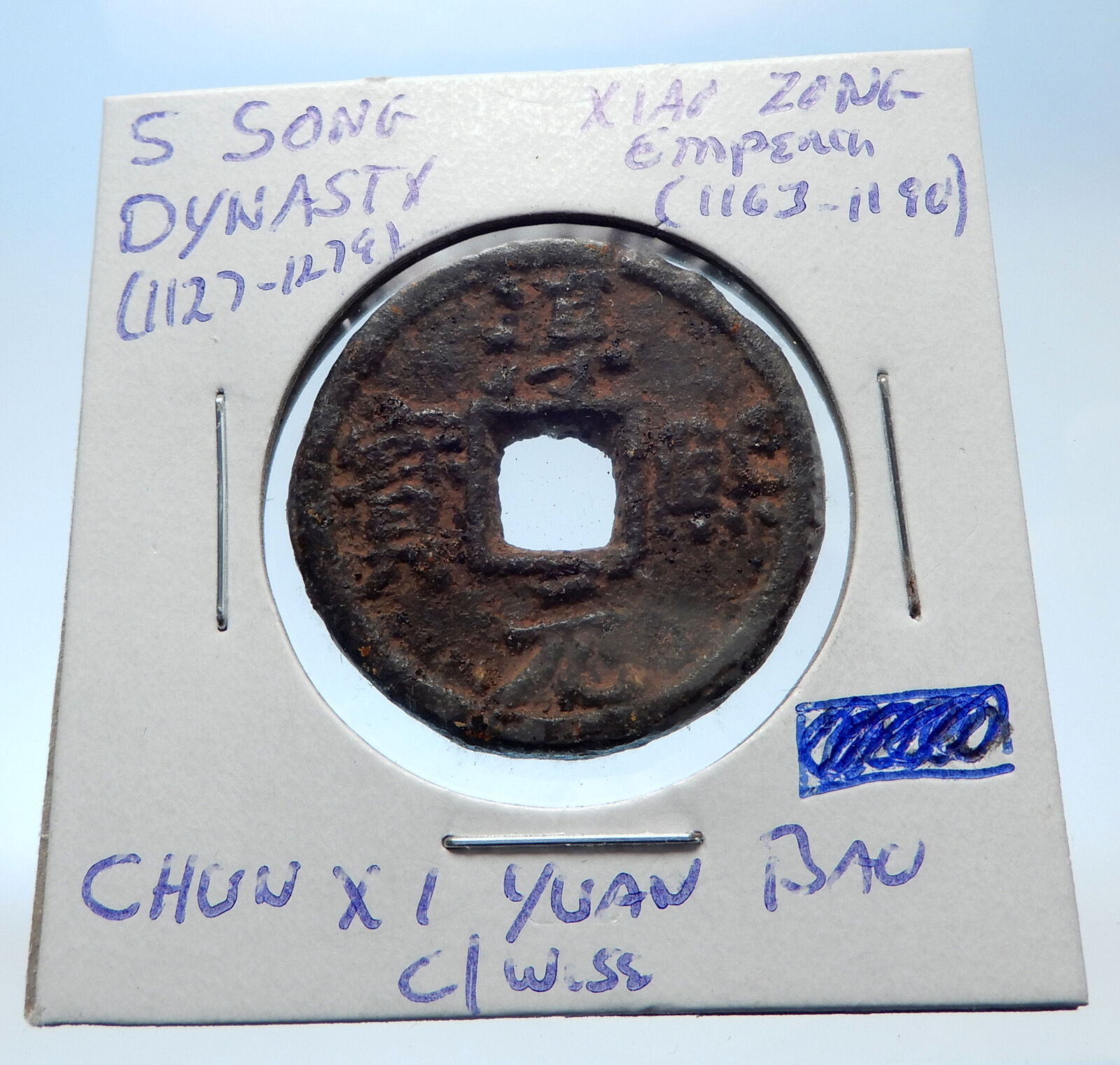|
China – Southern
Dynasties (502-589 AD) – Chen Dynasty (557-589 AD)
Emperor Xuan (557-589 AD)
Bronze Chen Wu Zhu Cash Token 23mm, Struck 557-589 AD
Reference: H# 10.22
Chinese Symbols.
You are bidding on the exact item pictured, provided with a Certificate of Authenticity and Lifetime Guarantee of Authenticity.
 Emperor Xuan of Chen (陳宣帝) (530–582), personal name Chen Xu (陳頊), courtesy name Shaoshi (紹世), nickname Shili (師利), was an emperor of the Chen dynasty of China. He seized the throne from his nephew Emperor Fei in 569 and subsequently ruled the state for 13 years. He was considered to be a capable and diligent ruler, who at one point militarily expanded at the expense of Northern Qi. After Northern Qi fell to Northern Zhou in 577, however, Chen was cornered, and soon lost the gains it had previously made against Northern Qi. Emperor Xuan died in 582, leaving the state in the hands of his incompetent son Chen Shubao, and by 589, Chen would be destroyed by Northern Zhou’s successor state Sui dynasty. Emperor Xuan of Chen (陳宣帝) (530–582), personal name Chen Xu (陳頊), courtesy name Shaoshi (紹世), nickname Shili (師利), was an emperor of the Chen dynasty of China. He seized the throne from his nephew Emperor Fei in 569 and subsequently ruled the state for 13 years. He was considered to be a capable and diligent ruler, who at one point militarily expanded at the expense of Northern Qi. After Northern Qi fell to Northern Zhou in 577, however, Chen was cornered, and soon lost the gains it had previously made against Northern Qi. Emperor Xuan died in 582, leaving the state in the hands of his incompetent son Chen Shubao, and by 589, Chen would be destroyed by Northern Zhou’s successor state Sui dynasty.
For reasons unclear in history, Chen Xu left the throne empty for more than a month, but finally took the throne in spring 569 (as Emperor Xuan). He honored Grand Empress Dowager Zhang as empress dowager instead, while Emperor Wen’s wife Empress Dowager Shen became known as Empress Wen. He created his wife Princess Liu empress and his heir apparent Chen Shubao crown emperor. Emperor Wen’s sons continued to have honored positions as imperial princes and held key posts, but none had particularly high power.
In fall 569, Emperor Xuan, suspicious that Ouyang He (歐陽紇) the governor of Guang Province (廣州, roughly modern Guangzhou, Guangdong) would rebel, summoned Ouyang back to Jiankang. Ouyang was himself suspicious of Emperor Xuan’s intentions, and therefore refused the order and rebelled. Emperor Xuan sent the official Xu Jian (徐儉, Xu Ling’s son) to try to persuade Ouyang to change his mind, but Ouyang would not relent. Emperor Xuan then sent the general Zhang Zhaoda (章昭達) to attack Ouyang. By spring 570, Zhang captured Ouyang and delivered him to Jiankang, where Ouyang was beheaded. Zhang, encouraged by the victory, then attacked Western Liang’s capital Jiangling, but after some initial gains, nearly capturing Jiangling, he suffered defeats by the Northern Zhou general Lu Teng (陸騰) and withdrew. Despite this campaign, however, after this point on, Chen and Northern Zhou largely had peaceful relations, often exchanging embassies, forming a rough alliance against Northern Qi.
In spring 573, Emperor Xuan resolved to attack Northern Qi—but when he discussed the matter with his officials and generals, they had split of opinion. Emperor Xuan, at the suggestion of Xu Ling, selected Wu Mingche, who alone among the generals was resolute as to his support for the campaign, as the commander of the forces, with Pei Ji (裴忌) and Huang Faqu (name not in Unicode) as Wu’s deputies. Wu’s forces made quick gains against Northern Qi, and by summer 573 had gained most of the territory between the Yangtze River and the Huai River. By fall 573, Wu put the important city Shouyang (壽陽, in modern Lu’an, Anhui) under siege, and he captured Shouyang in 573, capturing and killing the Northern Qi general in charge of defending the city, the former Liang general Wang Lin. The entire region between the Yangtze and Huai were now in Chen hands. Emperor Xuan was so pleased that he, in an elaborate ceremony, conferred a variety of honors on Wu. He also displayed Wang’s head on the Jiankang city gate, although after a request by Zhu Yang (朱瑒), in which Zhu pointed out that Wang was faithful to Liang and should be honored, he returned Wang’s head for a proper burial. In the following years, Chen continued to make minor gains against Northern Qi, but was not making major attacks.
In winter 576, Emperor Wu of Northern Zhou launched a major attack on Northern Qi, quickly capturing, in succession, Northern Qi’s secondary capital Jinyang (晉陽, in modern Taiyuan, Shanxi) and capital Yecheng. Soon, he captured the Northern Qi emperor Gao Wei and annexed most of Northern Qi’s territory by spring 577.
Oddly enough, Emperor Xuan believed that he could seize part of Northern Qi territory after Northern Zhou’s victory, and he sent Wu Mingche to again advance north. In winter 577, Wu put Pengcheng (彭城, in modern Xuzhou, Jiangsu) under siege, and Emperor Xuan was confident that Wu would soon be able to capture the region south of the Yellow River. When the official Cai Jingli (蔡景歷) warned otherwise, he was so displeased that he demoted Cai to the post of a commandery governor. In spring 578, the Northern Zhou general Wang Gui (王軌) thoroughly crushed Wu, capturing him. Regretting his actions, Emperor Xuan recalled Cai to the capital. With the people’s hearts shaken by the great defeat, in fall 578, Emperor Xuan held a ceremony in which the officials reaffirmed their loyalty to the state.
In winter 579, Emperor Xuan of Northern Zhou (Emperor Wu’s son and successor) launched an attack on Chen, commanded by the general Wei Xiaokuan. Chen’s Emperor Xuan mobilized his troops to resist. However, Chen forces could not stand against Northern Zhou’s attacks, and all of the cities that they had captured from Northern Qi previously quickly fell. By new year 580, nearly all of the territory north of the Yangtze had fallen to Northern Zhou, leading to a large wave of refugees who fled across the Yangtze to Chen territory.
In summer 580, Northern Zhou’s Emperor Xuan died suddenly, and his father-in-law Yang Jian seized power as regent. The generals Yuchi Jiong rose against Yang, and he was joined by the generals Sima Xiaonan (司馬消難) and Wang Qian (王謙). Sima, the governor of Xun Province (勛州, roughly modern Xiaogan, Hubei) and the nine surrounding provinces, soon surrendered to Chen, seeking Chen aid. Emperor Xuan sent the generals Fan Yi (樊毅), Ren Zhong (任忠), and Chen Huiji (陳慧紀) to attack Northern Zhou’s southern provinces to aid Sima, whom he created the Duke of Sui. However, Wei Xiaokuan quickly defeated Yuchi, forcing Yuchi to commit suicide, and Sima’s own forces collapsed. He was forced to flee to Chen territory, and all of the territory he controlled was retained by Northern Zhou. (Yang Jian soon seized the throne in spring 581, ending Northern Zhou and establishing Sui Dynasty)
In spring 582, Emperor Xuan died. After a failed attempt by his son Chen Shuling (陳叔陵), allied with Emperor Wen’s son Chen Bogu (陳伯固), to seize the throne, Crown Prince Shubao took the throne.
The Chen dynasty (simplified Chinese: 陈朝; traditional Chinese: 陳朝; pinyin: Chén Cháo; 557–589), also known as the Southern Chen (南陳 / 南朝陈), was the fourth and last of the Southern Dynasties in China. Following the Liang dynasty, the Chen dynasty was founded by Chen Baxian (Emperor Wu). The Chen dynasty further strengthened and revitalized the economy and culture of Southern China, and even made territorial expansions northward, laying the foundation for future dynasties. It was succeeded by the Sui dynasty in 589, marking an end to the Northern and Southern dynasties period in Chinese history. The Sui was a short-lived dynasty that collapsed and was eventually succeeded by the Tang dynasty. The descendants of the Chen imperial family continued to hold powerful high-ranking positions in the imperial courts of both the Sui and Tang dynasties.
Cash was a type of coin of China and East Asia, used from the 4th century BC until the 20th century AD. Originally cast during the Warring States period, these coins continued to be used for the entirety of Imperial China as well as under Mongol, and Manchu rule. The last Chinese cash coins were cast in the first year of the Republic of China. Generally most cash coins were made from copper or bronze alloys, with iron, lead, and zinc coins occasionally used less often throughout Chinese history. Rare silver and gold cash coins were also produced. During most of their production, cash coins were cast but, during the late Qing dynasty, machine-struck cash coins began to be made. As the cash coins produced over Chinese history were similar, thousand year old cash coins produced during the Northern Song dynasty continued to circulate as valid currency well into the early twentieth century.
In the modern era, these coins are considered to be Chinese “good luck coins”; they are hung on strings and round the necks of children, or over the beds of sick people. They hold a place in various superstitions, as well as Traditional Chinese medicine, and Feng shui. Currencies based on the Chinese cash coins include the Japanese mon, Korean mun, Ryukyuan mon, and Vietnamese văn.
|





 Emperor Xuan of Chen (陳宣帝) (530–582), personal name Chen Xu (陳頊), courtesy name Shaoshi (紹世), nickname Shili (師利), was an emperor of the Chen dynasty of China. He seized the throne from his nephew Emperor Fei in 569 and subsequently ruled the state for 13 years. He was considered to be a capable and diligent ruler, who at one point militarily expanded at the expense of Northern Qi. After Northern Qi fell to Northern Zhou in 577, however, Chen was cornered, and soon lost the gains it had previously made against Northern Qi. Emperor Xuan died in 582, leaving the state in the hands of his incompetent son Chen Shubao, and by 589, Chen would be destroyed by Northern Zhou’s successor state Sui dynasty.
Emperor Xuan of Chen (陳宣帝) (530–582), personal name Chen Xu (陳頊), courtesy name Shaoshi (紹世), nickname Shili (師利), was an emperor of the Chen dynasty of China. He seized the throne from his nephew Emperor Fei in 569 and subsequently ruled the state for 13 years. He was considered to be a capable and diligent ruler, who at one point militarily expanded at the expense of Northern Qi. After Northern Qi fell to Northern Zhou in 577, however, Chen was cornered, and soon lost the gains it had previously made against Northern Qi. Emperor Xuan died in 582, leaving the state in the hands of his incompetent son Chen Shubao, and by 589, Chen would be destroyed by Northern Zhou’s successor state Sui dynasty.




